Associazione Eugubini nel Mondo (original) (raw)
The family and youth | The studies | The priesthood and the clerical reform | A fire destroys Gubbio
The refusal to be bishop of Perugia | Ubaldo, bishop of Gubbio | The bishop ill-treated by a bricklayer | The civil war
Gubbio against eleven enemy cities | The bishop and the Emperor Barbarossa | The last years of his life
His death and the funerals | The canonization and the transfer of the body | The finger of Thann | Sources
The family and youth
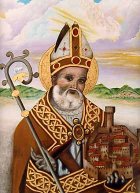 St. Ubaldo's exact birth date has not been accertained yet. He was probably bornmore or less in the year 1085.
St. Ubaldo's exact birth date has not been accertained yet. He was probably bornmore or less in the year 1085.
He was the only son of Rovaldo Baldassini, but he had a sister called Sperand�a, bigger than him. His mother, whose name maybe was Giuliana, was an invalid, seriously affected by a spastic disease.
The Baldassini family, maybe of german origin, was a family which became noble not long before, but was one of the most important in the city and was now considered a real eugubinian family. The Baldassini, who possessed domains at Carpiano, on the hills south of the city of Gubbio, had Baldassino as original family head, born in 1002, who was the great grandfather of our saint. St. Ubaldo's grandfather, Pace Baldassini, and the grandmother Pudenzia Armanni had two children: Rovaldo and Ubaldo, respectively father and uncle of St.Ubaldo.
When he was born, St.Ubaldo was baptized in the church of St. Giovanni, situated near the present one.
St. Ubaldo's life was difficult from the beginning. In fact, he became orphan of his father who died when he was still small and his mother died young too. For this reason his uncle Ubaldo took care of him.
The studies
He received his first schooling at the clergy of St.Secondo. Here he passed a happy period of his life and for this reason he remained affectioned to that church for all his life and when he was elected bishop, he left a patrimony to the church.
We are not sure of the period in which he continued studying at St.Secondo, but we are sure that he passed a short period at Fano, then at the clergy of St.Mariano at Gubbio. But in this parish St.Ubaldo wasn't happy and wished to go to a place of retreat, when he managed to return to St. Secondo church. The reason for this decision was because the clergymen of St.Mariano disgusted the young St.Ubaldo with their immoral attitude: community life was an exception, the only rule was the presence of women in the clergy: everyone had their own concubine!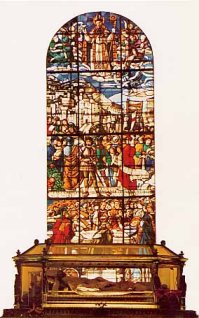 So therefore in 1104 St.Ubaldo was at St.Secondo church when the old bishop Rustico died and was succeeded by Giovanni of Lodi, man of great moral and spiritual reputation, who grew up at the school of St.Pier Damiani and was secretary, biographer, and prior successor at the monastery of Fonte Avellana.
So therefore in 1104 St.Ubaldo was at St.Secondo church when the old bishop Rustico died and was succeeded by Giovanni of Lodi, man of great moral and spiritual reputation, who grew up at the school of St.Pier Damiani and was secretary, biographer, and prior successor at the monastery of Fonte Avellana.
The new bishop wanted St. Ubaldo with him and therefore conducted him to St.Mariano.
They lived under the same roof for not even a year, in fact S.Giovanni of Lodi died in the autumn of 1005, but this short period was sufficient for the twenty year old S.Ubaldo to stimulate his passion and vocation of reformer of clerical life. Another Giovanni was nominated bishop, not more identified than the one before, and the clerical life which had improved in the last period, returned to its normal course. But this time St. Ubaldo didn't go back to St. Secondo and even if he received strong pressure to get married and have children, in this way regaining rights on the big patrimony of his family which was almost taken over by his relatives, he refused to do so by saying: _"Dear friend, I will never turn back on my decisions" and "nobody who puts their hands on a plough and then turns around is worthy to enter the kingdom of God". As far as children were concerned, he repeated: "He who loves his children more than me is not worthy of me"._It was now clear that his vocation was sincere and every day he sang to the Lord: "I only ask one thing from the Lord, that is to live in his house for the remainder of my days".
The Priesthood and the reform of the clergy
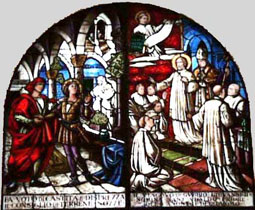
Three years later, in 1118, he became the prior of the parish of St.Mariano, to tell the truth, against his desire, but he had to accept.
"Prior Ubaldino", as they affectionately called him, worked hard on the clerical reforms of the church life. Unfortunately the clergical life was an exception, preferring the priests to live at their own homes; therefore even the religious functions were reduced to the bare necessities.
Ubaldo heard about a community of priests of St.Maria in Porto, near Ravenna, where Pietro of the Onesti wrote a Rule in 1116 which was the base of the life in that community, a rule which had been approved by Pope Pasquale II.
Ubaldo didn't hesitate and left for Ravenna by foot, because he wanted to find out personally how life was in that community based on that rule.
He got there in the first months of 1119, the prior Pietro of the Onesti was a marvellous teacher and example: but on the 29th of March 1119 he died, so all St.Ubaldo could do was copy the text of the Rules and return to Gubbio.
In this rule it was compulsory to surround the clergy house with a wall; to close the external door during the night; to maintain the absolute silence in the church, in the refectory and in the dormitory; not to go out more than two at the same time and only with the permission of the prior. There were also numerous fastings, daily bible reading, charity and hospitality to the poor and needy people. The clergymen had to be poor and therefore they didn't possess anything, for that reason St. Ubaldo was worried about the partitioning of his whole inheritance received from his father, leaving a small pert to his relatives, while he divided all the rest between the poor and the clergymen: a great "francescan" example but 80 years before!
On his return to Ravenna, Ubaldo obviously had some difficulty in having the Rule accepted; of all the clergymen present in St. Mariano, he only convinced three of them, but with their help the new reform slowly took its course and the clergy house became outstanding among others.
A fire destroys Gubbio
In 1126 a big fire destroyed Gubbio with its wooden houses, and even destroyed the clergy house of St. Mariano. St. Ubaldo was desperate, abandoned Gubbio and fled towards the nearest monastery of Fonte Avellana. But when the prior of that monastery, Pietro of Rimini, discovered the reason of his flee, he reproached him severely and warned him to return among his brothers who were left in great difficulty.
St.Ubaldo learnt the lesson and returned immediately to the ruins of his city and dedicated himself with body and soul to the reconstruction of his clerical house and the city itself.
The refusal to be bishop of Perugia
In the same year, 1126, the bishop of Perugia, Gennaro, died. A commission of perugians came to Gubbio to communicate to Ubaldo that he had been chosen as the new bishop.
But as soon as Ubaldo heard of it, he fled to a retreat in the surrounding mountains, but he knew that if the pope forced him into becoming bishop, he was obliged to do so. Then he secretly returned to the city and from there he continued on foot with four of his clerical brothers towards Rome and presented himself to Pope Onorio II.
He explained the reasons of his refusal to the pope. Onorio accepted the refusal of Ubaldo and the perugians were forced to chose another bishop (Rodolfo Armanni).
Ubaldo, Bishop of Gubbio
Ubaldo returns to Gubbio happy and relieved. Very little time passes and in 1129 the bishop Stefano dies in Gubbio, the eugubinian clergy can't find an agreement on the election of a new bishop, therefore a delegation goes to Rome to ask the pope to take the matter in his hands.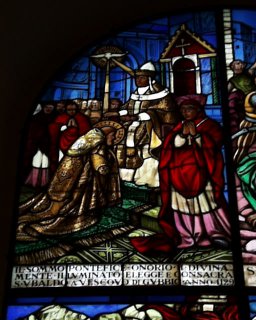
It was Ubaldo who was at the head of the delegation and Pope Onorio II obviously remembered him because of his visit few years before, when he refused to be bishop of Perugia.The pope had no doubt, and chose Ubaldo as the new bishop. Ubaldo tried to protest, but the pope was firm, and wished to make him bishop personally.
Ubaldo therefore returns from Rome, as bishop, but doesn't change his way of life. He continued living in the clergy house of St.Mariano and continued being "poor": maybe vegetarian, he ate very little and often only ate dry bread; his clothes were very thin, even if it was very cold; his bed was made of a mattress of very little hay and when it was too cold, he used his clothes to cover himself; in public he avoided any luxury. In other words he didn't seem to be a "bishop"! Even less to his relatives! They expected to have some advantages out of their bishop Ubaldo, but were shocked to see that it wasn't so.
They called him: "son of an abnormal woman", "useless person", "the shame of all bishops" and even reached the point of calling him: "wreched, if only you could die!".
Many other eugubinians thought the same way, but Ubaldo in exchange gave them his goodness, patience and forgiveness, in fact, he never "paid them back with their own medicine".
The Bishop ill-treated by a bricklayer
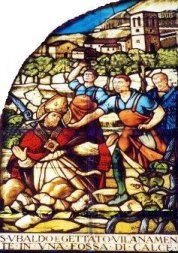 There is a famour episode which happened in the year 1140. The great reconstruction of Gubbio, which started after the fire of 1126 reached a good point.
There is a famour episode which happened in the year 1140. The great reconstruction of Gubbio, which started after the fire of 1126 reached a good point.
They were constructing the walls of the city facing the mountain (situated slightly lower than the present walls, constructed a century later), and between these walls, exactly on the mountainous vineyard of the bishop, they were constructing higienic services and its refuse substances ended up right in the vineyard. Ubaldo went to the vineyard and kindly asked the bricklayers not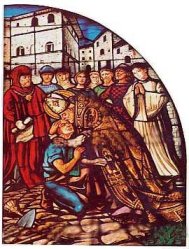 to carry out such an offensive operation towards him and his vineyard. Unfortunately the head of the bricklayers reacted badly by insulting and pushing the bishop until he fell into the cement which was prepared for the building: Ubaldo, who was completely messed, got up patiently and went back into the clergy house.
to carry out such an offensive operation towards him and his vineyard. Unfortunately the head of the bricklayers reacted badly by insulting and pushing the bishop until he fell into the cement which was prepared for the building: Ubaldo, who was completely messed, got up patiently and went back into the clergy house.
Something serious had happened, and it went over all limits, to the point that the disgust of the people grew so much that they wanted to break down the house of the bricklayer and condemn him to exile.
But then the Bishop reappeared, telling the people not to hurl their insults, because Jesus also underwent insults and even his death on the cross, but he never took revenge. He ended his speech saying: "You can't punish him without offending me!" He then had the bricklayer called, and the man threw himself at Ubaldo's feet, but Ubaldo pulled him up, with the words: "my son, I forgive you almighty God" and kissed him.
What a great example of umility and forgiveness! From that day onwards the Bishop Ubaldo was seen in a different light by the people.
The civil war
We are almost at the half of the XII century. It is the period of great political and social contrasts. From the political point of view the clash between Guelphs (supporters of the political power of the Pope) and the Ghibellines (supporters of the Imperator) started, but most of all the "new" clash between the two social classes worstened: on the one side the old feudal class of imperial origin, detainer of power, and on the other hand the new emerging class, which we could call the "middle class", composed of craftsmen, merchants who desired the increase of its their production and their commerce, and at the same time increase the richness of the city; obviously this class gained political control of the city ( in fact, towards the 1140 the first Consoli were elected).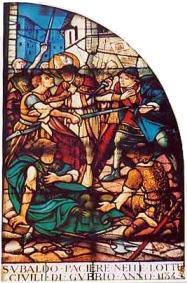
The clashes were always more frequent and bloody. One day the tention grew so much that the piazza of S. Giuliano became a real battle field and the victims were numerous from both sides.
The Bishop Ubaldo was called and he immediately went to the point of the battle, but could not manage to make peace, so he threw himself in the middle of them, between the swords of the fighters, and all of a sudden he fell to the ground. Then everyone recognized Ubaldo, the Bishop, and they were afraid he would be dead; suddenly everyone stopped fighting and became worried, until a big crowd was formed around him, from both political sides, screaming and blaming themselves for his death.
But Ubaldo wasn't deat. He used this trick to convince the eugubinians to stop the battle and civil war.
When he realized that nobody wanted to continue fighting, and resolving problems with arms, Ubaldo got up calmly, and with his hand he thanked God for not having caused any victims.
Then everyone enjoiced and he severely reprimanded them and made them promise never to use arms again, because they should have been satisfied with using their ..... hands!
Gubbio againist eleven enemy cities
The civil war had now been avoided, but the political protests continued the same: once the "democratical" side gained power, they exerted it and many "aristocrats" were sent into exile. The bishop disapproved this measure but could not avoid it.
These exiles didn't give up, they plotted secretly and slowly looked for allies against the city of Gubbio that sent them out.
They managed to organize a proper military alliance against Gubbio without much trouble. In fact, Gubbio was envied because of its geographical position, for its intense political passion, for its prosperity and most of all for its expansionistic politics. Gubbio was also object of avidity and fear on behalf of the neighbouring cities who wanted to humiliate and limit the power of Gubbio.
All the big neighbouring cities formed part of the coalition against Gubbio e.g. Perugia, Citt� di Castello, Cagli, Sassoferrato, Nocera, Foligno, Spoleto and Assisi; including the Counts of Fossato, of Coccorano and Val Marcola.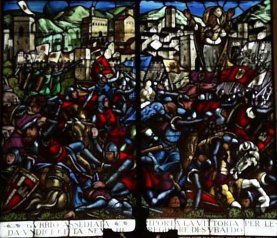
The coalition army, lead by Perugia, camped out in the plains near the walls of Gubbio, and came nearer and nearer to the city day by day, and the city walls weren't even completed yet.
The numerical disproportion between the army of the allies and that on which Gubbio counted was very great: 14 to 1.
Some people say that it was even 40 to 1!
The fear in the city grew day by day.
While facing this tragic situation, the eugubinians were drawn still closer to their Bishop Ubaldo and tried to find a solution with him.
Obviously, as before, they tried the dipomatic solution: they made three tentatives, but no solution which was suggested was accepted by the perugians and their allies who intended dividing the areas conquested by the battle.
At this point the old bishop was forced to accept the use of arms. But first he called the people to the church of St. Mariano and said: "Brothers, don't be afraid of the multitude of enemies: if the Lord has intention of freeing us, they cannot do us any harm; if the Lord has decided to punish us, he can destroy us even without their help" and continued: "God hates sins, but not sinners; punish yourselves for the sins you have committed! Because in the name of the Lord I promise you that we will win the battle: only on condition that your sins have been cancelled with penetence."
Giordano, belonging to the same period and biographer of St. Ubaldo, writes that when the Eugubinians heard these words, they rushed to do their penetence, and their sins came to the light, and they tried being better persons". For another "three Days the city was overwhelmed by processions, hymns and prayers. Ahead there was the priest, near him the clergyman, and then the crowd of men, and at last the women: all of them were barefoot. For who desired to have communion, there was the host.
The prayers were followed by a victorious battle, prepared with care and military strategies: when the sun was setting a big group of chosen soldiers left the city on the north side, towards the mountain of Ingino, with the advantage of the dark they climbled up the slopes to then go down the **gola of the Bottaccione**and to once again climb up mount Calvo to descend into the plains and with a surprise attack their enemies. But this plan included also a frontal attack. In fact, the doors of the city suddenly opened and the eugubinian soldiers attacked their enemies who were camped outside the city walls.
The enemies were rapidly defeated. To flee was their only solution. When the eugubinians entered the enemy camps, they found enormous quantities of food and materials. It took them many days to transfer everything into the city.
The first of the four wars between Gubbio and Perugia had ended!
The Bishop and the Imperator Federico Barbarossa
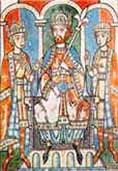 But the great dangers for this young comune were not at an end yet. In fact in 1154 the Imperator Federico 1 of Svevia, also called "Barbarossa" came to Italy, called by the Comunes of Lombardy who were battling among themselves. The Imperator had to face a situation which was very difficult to control: the Comunes, unlike the old Feudians, didn't accept imperial rule. Obviously Barbarossa couldn't tolerate such a situation and had to insist that the total power was in his hands: he made it clear to all the representatives of the Comunes present at the "Diet of Roncaglia".
But the great dangers for this young comune were not at an end yet. In fact in 1154 the Imperator Federico 1 of Svevia, also called "Barbarossa" came to Italy, called by the Comunes of Lombardy who were battling among themselves. The Imperator had to face a situation which was very difficult to control: the Comunes, unlike the old Feudians, didn't accept imperial rule. Obviously Barbarossa couldn't tolerate such a situation and had to insist that the total power was in his hands: he made it clear to all the representatives of the Comunes present at the "Diet of Roncaglia".
However Barbarossa took time, he didn't face the situation immediately, and he was crowned King of Italy at Pavia, and then came to Rome to show Pope Adriano IV his new crown.
At the beginning of 1155 he continued on towards the North, followed the Via Flaminia, and passed through Spoleto. The city didn't consent to the demands of the Imperator and he conquested and completely destroyed the city. Then, continuing in the direction of Ravenna, he arrived near Gubbio, where the army camped. He asked the city to pay a big sum of money, as some of Gubbio's enemies had advised him to do.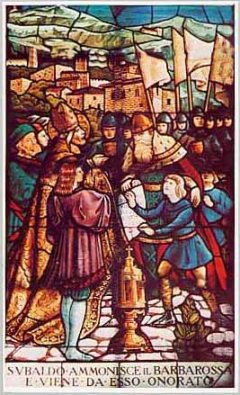 The sum asked was enormous and impossible to pay, the possibility to pay it in rates was not accepted, the days passed and the risk of going through the same experience as the city of Spoleto was even more frightening.
The sum asked was enormous and impossible to pay, the possibility to pay it in rates was not accepted, the days passed and the risk of going through the same experience as the city of Spoleto was even more frightening.
The Eugubinians once more asked help from their bishop Ubaldo.
Ubaldo was very ill, but realized the gravity of the situation and spontaneously decided to present himself to Barbarossa. Now comes the shocking part: the imperator who wants to destroy Gubbio, when seing his old bishop, humbled himself and annulled all his mean plans. Giordano writes: "The imperator received him with solemnity" and "lowered his head to ask for a blessing". Then St. Ubaldo talks to him: "He who gave you the crown to govern on earth, giveth you the right to go to heaven". Federico, who had been longing to meet the bishop, sat near him and gave him a splendid silver cup as a present. This put an end to the hostility.
Once again Gubbio was saved by its bishop!
The meeting between the Bishop Ubaldo and Barbarossa made such an impression on everybody that eight years later, in 1163, three years after the death of St. Ubaldo, the Eugubinians offered the Imperator the "Vita di S. Ubaldo", written by his successor Teobaldo and dedicated to Federico, who dedicated to Gubbio the famous "Diploma" with which Gubbio was recognized at the Comune of Gubbio and the exemption of taxes, and the right to elect the Consuls: which was exactly what the free comune desired!
The last years of his life
The last years of his life were really full of trouble. He had a serious disease which covered his whole body with cysts from which a serum came out with a bad odour. He was forced to change his underwear many times a day, and as soon as the underwear cooled off, it became as hard as leather.
He became skin and bone, and there was hardly any flesh left on his body.
Ubaldo reached the spring of 1160 in these conditions. Before easter, which was on the 27th March, the eugubinians thought that it would be the last easter they would have passed with their bishop. They formed a small delegation and went to Ubaldo to ask him to celebrate the mass. It was Bambo, one of the Consuls, who entered the room saying: "...Christ has loved his children until the end .... you that have lived until today not for yourself, but for us .... celebrate Holy Mass for us today". When Ubaldo heard these words, he got emotionally upset and even though he had very much pain, he ordered that the necessary things be prepared for the mass and to help him walk to the Cathedrall. While the bells were ringing, a great crowd gathered in front of the Duomo. It was his last salute to his people. In his last preach he talked about eternal life, of Paradise, as if he would have liked to see them all up there.
Giordano writes that after the Mass, Ubaldo was taken almost dying to a bed prepared in the church of S. Lorenzo and remained there until 5 May, when he asked to go back to St. Mariano. Passing his days praying, on the 15th May, on Pentecost day, when the holy spirit descended onto the Apostles, he asked for extreme unction.
His death and the funerals
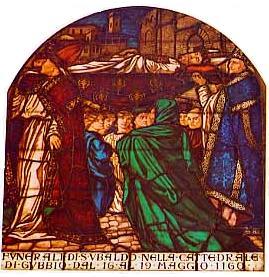 At sunrise on Monday, 16th May 1160, his soul ascended to God.
At sunrise on Monday, 16th May 1160, his soul ascended to God.
The news of his death brought an unconsolable sadness among the people. Gubbio didn't only lose its Holy Bishop, but also the most important of its citizens: an eugubinian who with his teaching, with his sweetness, but also with his energy and authority made of Gubbio a great important city.
Even though with tears, the body was prepared and dressed with bishop's clothes and taken into church.
During those days the weather was fine and the temperature was warm. This encouraged the arrival of people in the city, a great crowd came from the nearby cities. The pilgrims became more and more.
Even though it was very hot, the body of Ubaldo did not have any bad odour, and Giordano says that "his flesh was clean and without any sore, apart from the sore on his right hand".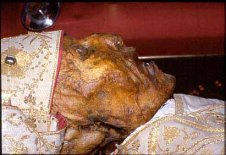 Between the pilgrims there were various miraculous healings, which caused enthusiasm and veneration towards the Saint. So the crowds grew more and more, until it was impossible to close the church door even at night.
Between the pilgrims there were various miraculous healings, which caused enthusiasm and veneration towards the Saint. So the crowds grew more and more, until it was impossible to close the church door even at night.
The first three days after his death passed with hymns and song sung by the people. On the fourth day, the Thursday, it was necessary to bury the body for public reasons, due to the great arrival of the crowds.
It was Raniero, bishop of Cagli and nephew of St. Ubaldo, who announced to the people that he would be buried. The people reacted with desperate weeping. Everyone cried: men, women, young and old.
When, between sorrow and weeping, the holy body was lifted up in the middle of the church, asif it was going up into heaven, everyone asked for his protection and help. The eugubinians, one by one, greeted their Saint and Bishop with their arms up to the sky, crying: "Oh, St.Ubaldo, protect this city, defend your Church" and then "Oh, St.Ubaldo, defend this crowd that is united today in your honour".
The holy body was put in a sarcophagus of marble next to the tomb of the saints Mariano and Giacomo. The burying of the body didn't stop the pilgrimage, in fact the church of St. Ubaldo was always full of his followers from other cities: in the roads of Gubbio they sang hymns in honour of St. Ubaldo. Every night after that the whole city was lit up by pilgrims who walked around the city with "Ceri" lit up to go to the tomb of St. Ubaldo.
Giordano remembers that: "All hatred was set apart, fights turned into friendship, and enemies made peace".
That whole year was a jubilar year, full of happiness and joy; the generosity towards the poor increased and in the whole territory of Gubbio there was no needy person. The rich families donated large quantities of food to the church of St. Mariano for the poor pilgrims that arrived at the tomb of the Saint.
Teobaldo, successor and biographer of St.Ubaldo remembers: "the good citizens had the habit of coming every day, with lit candles to the tomb of St. Ubaldo. They arrived in procession, singing hymns, men and women. The city of Gubbio echoed with the voice of the songs and shone with the light of the CERI lit up."
The canonization and the removal of the Body
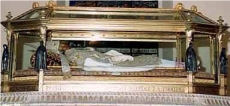 The two biographers, Giordano and Teobaldo, are of the same period and friends of our Saint, and wrote his biography in the first three years after his death, in fact in 1163 Teobaldo donates and dedicates his works to the Emperor Federico Barbarossa. They explain many miracles which took place, by the intercession of the bishop saint, in the days before his burial. They remember that in those days he made blind people see, deaf people hear, cripple people walk, but in his tomb he continued making miracles, eliminating demons and curing illnesses.
The two biographers, Giordano and Teobaldo, are of the same period and friends of our Saint, and wrote his biography in the first three years after his death, in fact in 1163 Teobaldo donates and dedicates his works to the Emperor Federico Barbarossa. They explain many miracles which took place, by the intercession of the bishop saint, in the days before his burial. They remember that in those days he made blind people see, deaf people hear, cripple people walk, but in his tomb he continued making miracles, eliminating demons and curing illnesses.
The fame of his healing powers soon became known all over and people came from far for comfort and health.
These facts are witnessed by the "Bolla di canonizzazione" given by Pope Celestino III, on the 5th March 1192, thirty two years after his death, in which the pope affirms: "he was pious and right when he lived on earth, after his death for the miracles which God allowed him to make in his name, he was respected by people near and far."
The Eugubinians proclaimed him "Saint and protector" in their hearts, as soon as his soul ascended to heaven. In fact he was buried in the tomb of the martyrs Mariano and Giacomo, protectors of G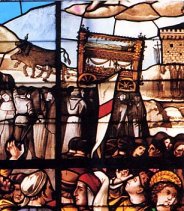
Two years later, on 11th September 1194, the body of St.Ubaldo was transferred from the Cathedral to a little church built on mount Ingino not far below the rock and near the parish of St.Gervasio.
We aren't sure of the exact reason why the body was transferred, but certainly the war between the two parties, the guelphans, and the ghibellines, is partly responsible for this decision. In fact, after various incidents, in those years it seemed asif the power was in the hands of the guelphans, but this caused the fear of being attacked by the imperial army or any other city. If we also add the fact that at those times it was normal that during the pillaging of a city, they stole bodies of saints, we understand why the eugubinians preferred placing the body of St. Ubaldo in a fortified place, exactly under the Rock of the mountain. From then onwards Mount Ingino was called the "Mountain of St.Ubaldo".
During the following eight centuries which divide us from that date, the Body of St.Ubaldo was taken back to the city five times.
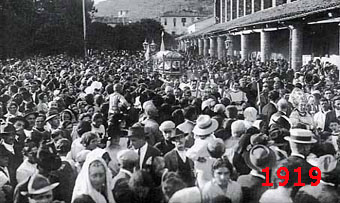
In August 1919, to celebrate the end of the first world war, the bishop Carlo Taccetti wanted to "thank St.Ubaldo for accompanying his children to the top of the Alps".
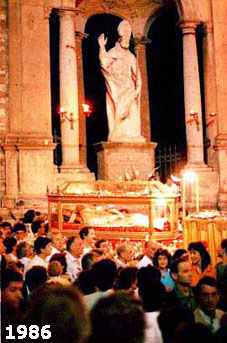
In September 1929, the bishop Pio Navarra, to celebrate the solemn 8th centenary of the consecration of St.Ubaldo as bishop of Gubbio (1129).In May 1960, , the bishop Beniamino Ubaldi, in occasion of the eight hundredth anniversary of St.Ubaldo's death.In September 1986, the bishop Ennio Antonelli, in occasion of ninth centenary of his birth.Finally in September 1994, the bishop Pietro Bottaccioli, in memory of the "traslazione" (transfer) of eight centuries ago.
The finger at Thann
It's dutyful to remember that the transfer of a small part of the body of St. Ubaldo to Thann, city of the region of Alsace in France.
A legend says that when St. Ubaldo was alive, he told his servant, who was originally from Northern Europe, that when he died he could have his episcopal ring. The servant did what he was told to do, but instead of pulling off the ring, he pulled away the whole thumb. The servant was shocked, and kept the
After about a year, on the 30th June 1161, he reached the valley where Thann now is. It was a very hot day and he was very tired, so he put the stick near a tree and fell asleep in the shade of a fir tree. When he woke up, he wanted to continue his walk, but couldn't manage to pull the stick off the ground. In the meantime Count Enghelhard from his castle saw three flames coming out of the top of the tree without the tree burning and he immediately ran to see what was happening. There he found a man praying in front of his stick. The servant told his story and the count, who interpreted the fact as a divine sign, promised to build a small church to preserve that relic. After that the stick immediately came loose from the ground.
This is the legend, but the rest of the story confirms it, al least in the facts. The chapel really was constructed, after that the first houses were built, and the city of Thann was born.
The inhabitants have always celebrated the founding of their city on the 30th of June. Two centuries later the actual church was constructed, the "Coll�giale de St.Thi�baut", a splendid example of gothic art, where the relic of St. Ubaldo is conserved, a relic which since 1975 we know for sure to be part of St. Ubaldo's little finger of his right hand and not his thumb, as the legend said.
St.Ubaldo is object of great cult at Thann, even if the name has been changed to: Thi�baut (Teobaldo) probably because the name Ubaldo, unknown in the germanic zone, sounded like the diminutive of Teobaldo.
The devotion to St. Ubaldo created great ties between Thann and Gubbio, to the point that the people of Thann usually say: "Thann est la fille a�nee de Gubbio" (Thann is the eldest daughter of Gubbio).
Translation of Virginia Borio Ambrogi - Gubbio- Italy
SOURCES
FANUCCI A. M.
"S. Ubaldo, il suo vero volto" (La vita Beati Ubaldi del suo confratello Giordano riletta da Don Angelo M. Fanucci) edizioni Universit� Muratori, Famiglie Ceraiole e Maggio Eugubino, Gubbio 2007.
Con il permesso dell'Autore, la riproduzione del libro di 130 pagine, in formato pdf, ci � stata messa a disposizione dalla Tipografia Donati
![]() Esegui il Download del libro
Esegui il Download del libro 
********************************************
AMBROGI M.G. - BELARDI G. - GAGLIARDONI I.
Gubbio, S. Ubaldo e la grande guerra, "Edizioni Porziuncola" Assisi 1991.
********************************************
BARBI A.
La Festa dei Ceri durante l'ascesa del fascismo, "Edizioni Ceraiole" direzione A. Barbi, Gubbio 2000.
********************************************
BRACCINI U.
La mano di S. Ubaldo, Alla ricerca della verit� sui legami tra Thann e Gubbio, edito da "Santuario di S. Ubaldo", Gubbio 1993.
![]() Esegui il Download del libro
Esegui il Download del libro 
********************************************
BRACCINI U.
Studi sul Corpo del Protettore S.Ubaldo 1976
![]() Esegui il Download dell'articolo
Esegui il Download dell'articolo 
********************************************
Bottaccioli P.
Biografia di S.Ubaldo, in cammino con S. Ubaldo - 1992
![]() Esegui il Download dell'articolo
Esegui il Download dell'articolo 
********************************************
CENCI P.
Il Culto di S. Ubaldo dalla morte alla traslazione, edito "Famiglie Ceraiole" direzione A. Barbi, Gubbio 1994.
********************************************
**Cianchini G.**et al.
Studio sulle cause di morte di S. Ubaldo, Journal of the European Academy of Dermatology - 2017
![]() Esegui il Download dell'articolo
Esegui il Download dell'articolo 
********************************************
FANUCCI A. M.
Ubaldo Baldassini, novecento anni dopo, edizioni Comunit� S. Girolamo, Gubbio 1986. ![]() Esegui il Download del libro
Esegui il Download del libro 
********************************************
GIORDANO da Tiferno
Vita di S. Ubaldo, edito dalla "Famiglia dei Santantoniari" a cura di A.M. Fanucci, Gubbio 1979.
![]() Esegui il Download del libro
Esegui il Download del libro 
********************************************
NASALLI ROCCA Mons. G. B.
SANT'UBALDO, Tipografia S. Lega Eucaristica, Milano 1914.
![]() Esegui il Download del libro
Esegui il Download del libro 
********************************************
ROGARI O.
Vita di S. Ubaldo, 1960.
![]() Esegui il Download del libro
Esegui il Download del libro
********************************************
ROGARI O.
Nascita di S. Ubaldo, Via Ch'eccoli 1985.
![]() Esegui il Download dell'articolo
Esegui il Download dell'articolo
********************************************
TEOBALDO
Leggenda del Beato Ubaldo, vescovo di Gubbio, tipografia vescovile, Gubbio 1860.
********************************************
TEOBALDO(sec.XII)
Vita di Sant'Ubaldo (a Cura di Don Angelo Fanucci - Edizioni Ceraiole, 2019)
![]() Esegui il Download del libro
Esegui il Download del libro 
********************************************
Speziali G.
Biografia di S. Ubaldo, Santuario di S. Ubaldo, marzo 1981.
![]() Esegui il Download dell'articolo
Esegui il Download dell'articolo
